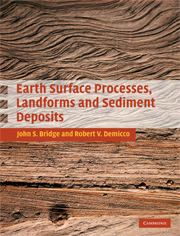Book contents
- Frontmatter
- Contents
- Acknowledgments
- Figure credits
- PART 1 Introduction
- PART 2 Production of sediment at the Earth's surface
- PART 3 Fundamentals of fluid flow, sediment transport, erosion, and deposition
- 5 Unidirectional turbulent water flow, sediment transport, erosion, and deposition
- 6 Air flow, sediment transport, erosion, and deposition
- 7 Multidirectional water flow, sediment transport, erosion, and deposition
- 8 Movement of sediment by gravity
- 9 Generation and movement of volcaniclastic sediment
- 10 Ice flow, sediment transport, erosion, and deposition
- 11 Biogenic and chemogenic depositional structures
- 12 Post-depositional deformation of soft sediment
- PART 4 Environments of erosion and deposition
- PART 5 Sediment into rock: diagenesis
- PART 6 Long-term, large-scale processes: mountains and sedimentary basins
- References
- Appendix: Methods of study of Earth surface processes, landforms, and sediments
- Index
- Plate section
6 - Air flow, sediment transport, erosion, and deposition
from PART 3 - Fundamentals of fluid flow, sediment transport, erosion, and deposition
Published online by Cambridge University Press: 05 June 2012
- Frontmatter
- Contents
- Acknowledgments
- Figure credits
- PART 1 Introduction
- PART 2 Production of sediment at the Earth's surface
- PART 3 Fundamentals of fluid flow, sediment transport, erosion, and deposition
- 5 Unidirectional turbulent water flow, sediment transport, erosion, and deposition
- 6 Air flow, sediment transport, erosion, and deposition
- 7 Multidirectional water flow, sediment transport, erosion, and deposition
- 8 Movement of sediment by gravity
- 9 Generation and movement of volcaniclastic sediment
- 10 Ice flow, sediment transport, erosion, and deposition
- 11 Biogenic and chemogenic depositional structures
- 12 Post-depositional deformation of soft sediment
- PART 4 Environments of erosion and deposition
- PART 5 Sediment into rock: diagenesis
- PART 6 Long-term, large-scale processes: mountains and sedimentary basins
- References
- Appendix: Methods of study of Earth surface processes, landforms, and sediments
- Index
- Plate section
Summary
Introduction
Air flow is a significant agent of erosion, sediment transport, and deposition over subaerial surfaces that lack a protective cover of vegetation, such as deserts, sandy beaches, floodplains exposed after floods, and outwash plains of glacial meltwater streams. The mechanics of air flow, sediment transport, erosion, and deposition have been studied in the field and in wind tunnels, and are similar to those of unidirectional water flows (e.g., Allen, 1982a; Greeley and Iverson, 1985; Pye and Tsoar, 1990; Nickling, 1994; Lancaster, 1995, 2005). To avoid repetition of material in Chapter 5, emphasis will be placed on the differences between air flows and water flows and the associated sedimentary processes.
Mechanics of air flow
Air has much lower density than water (1.3 kg m− 3 versus 1,000 kg m− 3), and much lower viscosity than water (1.78 × 10− 5 N s m− 3 versus 1.00 × 10− 3 N s m− 3). The density of air increases as temperature decreases and increases as pressure increases because air is compressible. Air speeds regularly exceed water speeds by an order of magnitude. For example, a river in flood may have a mean flow velocity of 1 m s− 1, where as a strong wind may be tens of m s− 1. This means that air flows are always turbulent, and resistance to motion is due to turbulent shear stress entirely.
- Type
- Chapter
- Information
- Earth Surface Processes, Landforms and Sediment Deposits , pp. 195 - 212Publisher: Cambridge University PressPrint publication year: 2008



